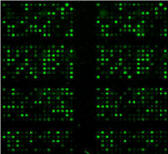Proteome is referenced as the result of expression of the whole genome. With the recent developments of genomics, one could consider that this analysis is enough to decipher any biological mechanism…
But depending on your sample, some regulations occur, that are not directly linked to the genes: isoform splicing, post-translational modifications (such as phosphorylation, acetylation & glycosylation), secretion…
Genomics, although powerful, does not allow the analysis of such protein-specific modifications. To overcome these limits, proteomics emerges, with specific subsets having specific requirements. Here, I’d like to put the Secretome and Kinome in the highlight!
Secretome & Kinome: the trendy proteome subsets!
Secretome represents the proteins that are secreted from cells: messengers as cytokines, chemokines, growth factors… But also soluble receptors or extracellular matrix proteins. Their secretion is strictly regulated, and they are considered inactive as long as they are not released in the extra-cellular environment, or the circulation.
Kinome represents a set of kinases involved in cellular signaling pathway activation. The phosphorylation status of a protein is a key factor to determine its activity status. Thus, the activation level of a transduction pathway can be estimated by evaluating the phosphorylation level of its proteins.

Why are Secretome and Kinome such hot topics?
These proteome subsets have various applications. Secretome and Kinome have already been used in:
- Fundamental research – To understanding biological mechanisms
- Pharmaceutic industry – To identify new therapeutic targets
- Diagnostics/pronostics – To define new biomarkers
- Personalized medicine – To discover biomarker showing the efficiency of a drug, or allowing to classify each patient in a cohort that will receive a specific treatment…
The secretome used to be the immunologist’s favourite subject, but more topics have recently been raised, such as cancer research with the study of the communication between cancer cells and their environment (1) or propagation of metastatic cells (2).
Secretome biomarkers are especially interesting since they can be isolated from blood (more accessible, less intrusive than biopsies…)
What about Kinome? The kinome biomarkers might be the ones to find out when considering cancer cell growth deregulation. In this case, it is no more the expression or the secretion of a protein, but its phosphorylation level, which becomes the target/biomarker. (3)
Are you a Kinome or Secretome fan?
Contact us to discover how we can help you to identify new markers!
[contact-form to=’myantibody@tebu-bio.com’ subject=’Kinome/secretome tools’][contact-field label=’Name’ type=’name’ required=’1’/][contact-field label=’Email’ type=’email’ required=’1’/][contact-field label=’Comment’ type=’textarea’ required=’1’/][/contact-form]
(1) Inflammatory cytokines and signaling pathways are associated with survival of primary chronic lymphocytic leukemia cells in vitro: a dominant role of CCL2 (Angela Schulz et al., Haematologica, March 2011 96:408-416)
(2) Differential secretome analysis reveals CST6 as a suppressor of breast cancer bone metastasis (Jin L et al., Cell Res. 2012 Sep;22(9):1356-73)
(3) Defining the expressed breast cancer kinome (Alicia A Midland et al, Cell Research (2012) 22:620–623)



